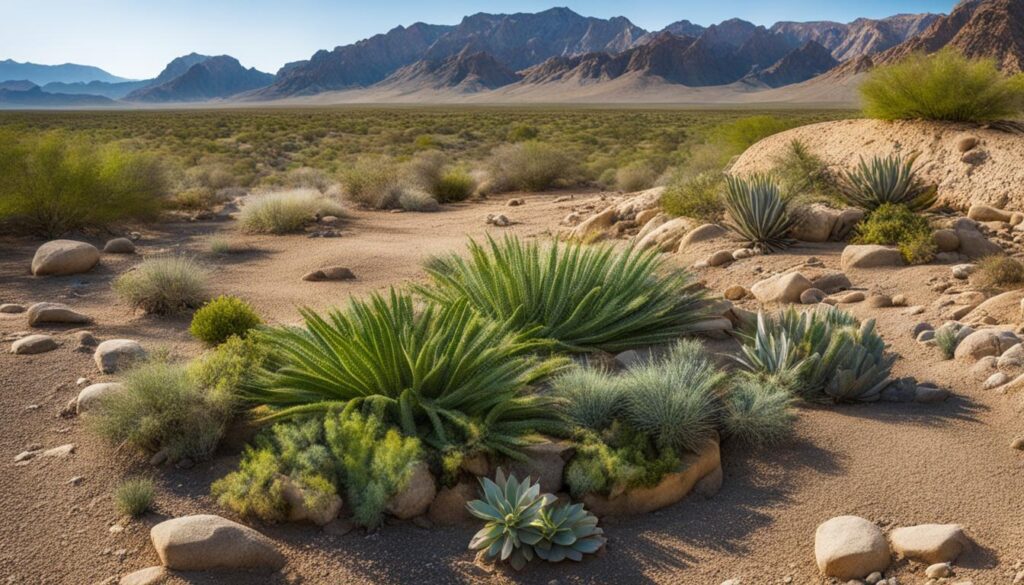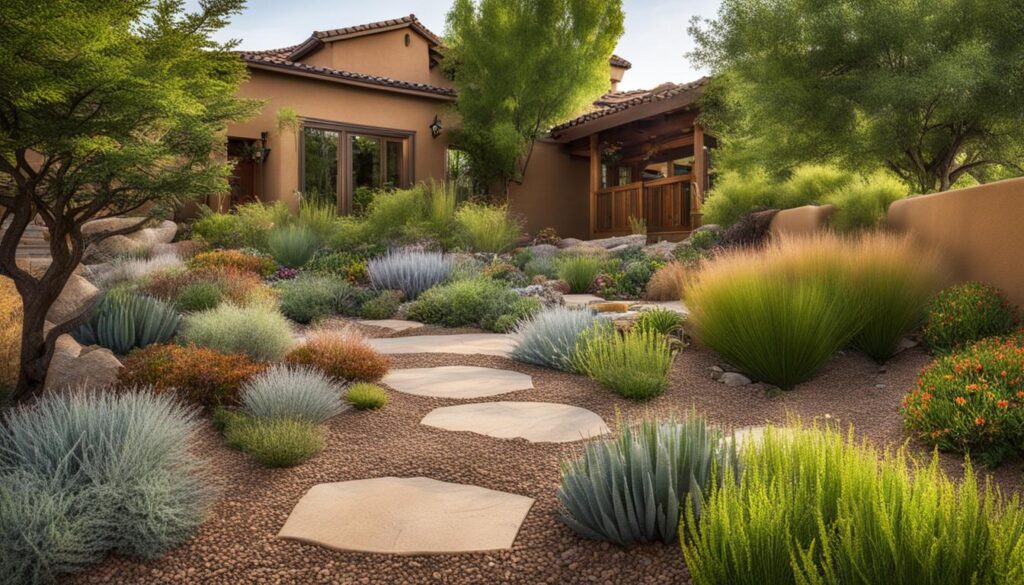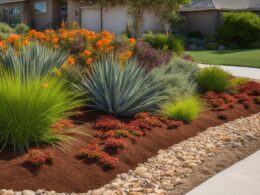Are you looking for an eco-friendly and cost-effective way to landscape your outdoor space? Xeriscaping is the answer! By incorporating cost-saving native plants, xeriscaping not only creates beautiful landscapes but also promotes water conservation and sustainability. With the use of drought-resistant plants and minimal maintenance requirements, xeriscaping is the perfect solution for homeowners and landscape architects who want to create stunning outdoor environments while being mindful of their impact on the environment and their budget.
Key Takeaways:
- Xeriscaping is a sustainable landscaping strategy that focuses on water conservation.
- Using native plants that require minimal water and maintenance can help reduce costs.
- Xeriscaping promotes eco-friendliness and creates visually appealing landscapes.
- Water conservation, cost savings, and increased property value are some of the benefits of xeriscaping.
- Proper soil preparation, efficient irrigation, and regular maintenance are key factors for successful xeriscaping.
The Benefits of Xeriscaping
Xeriscaping offers numerous benefits that make it an attractive choice for homeowners and landscape architects. One of the primary advantages of xeriscaping is water conservation. Compared to traditional landscapes, xeriscaping can reduce outdoor water usage by up to 75%. This is achieved through the use of drought-resistant plants and efficient irrigation systems, which minimize water waste and promote environmental sustainability.
In addition to water conservation, xeriscaping also provides cost savings. By using native plants that are adapted to the local climate, homeowners can reduce their water bills and landscaping maintenance expenses. Furthermore, xeriscaping can increase the property value of a home. The aesthetic appeal of a well-designed xeriscape can enhance curb appeal and attract potential buyers, making it a valuable investment.
Another advantage of xeriscaping is the use of drought-resistant and native plants. These plants are well-suited to the local environment, requiring less water and maintenance compared to non-native species. By choosing plants that are adapted to the region, xeriscaping can create beautiful landscapes that thrive in challenging conditions.
“Xeriscaping is not only environmentally beneficial but also economically advantageous. By conserving water, reducing maintenance costs, and enhancing property value, this sustainable landscaping technique offers a win-win solution for homeowners.” – Landscaping Expert
| Benefits of Xeriscaping | |
|---|---|
| Water Conservation | Reduces outdoor water usage by up to 75% |
| Cost Savings | Reduces water bills and landscaping maintenance expenses |
| Property Value | Increases the value of the property through enhanced curb appeal |
| Drought-Resistant Plants | Thrives in challenging conditions with minimal water and maintenance |
| Native Plants | Adapted to the local environment, requires less water and maintenance |
Environmental Sustainability
Xeriscaping promotes environmental sustainability by preserving natural resources and supporting local biodiversity. By reducing the use of water and chemicals, xeriscaping helps conserve precious resources and prevents pollution of waterways. The focus on native plants also benefits local wildlife and encourages the growth of native species, contributing to the overall health of the ecosystem.
Enhanced Aesthetics
Contrary to popular belief, xeriscaping can create visually stunning landscapes. By carefully selecting drought-resistant plants and incorporating hardscaping elements, such as rocks and pathways, xeriscapes can achieve a harmonious and inviting atmosphere. With thoughtful design and maintenance, xeriscaping can transform a dry and barren yard into a vibrant and attractive outdoor space.
Long-Term Sustainability
One of the key advantages of xeriscaping is its long-term sustainability. With proper planning and maintenance, xeriscapes can thrive for years to come, requiring minimal water and maintenance. By embracing xeriscaping principles, homeowners can enjoy beautiful landscapes while contributing to a more sustainable future.
Example of Xeriscaping
Transitioning to xeriscaping involves careful consideration of various cost factors. While there may be initial expenses, such as installing an efficient irrigation system and selecting drought-tolerant plants, the long-term savings can outweigh the upfront investment. By reducing water consumption and maintenance expenses, xeriscaping can lead to significant cost savings over time.
One of the key cost considerations in xeriscaping is the selection of plants. Opting for native, drought-tolerant plants can help minimize water usage and maintenance needs. These plants are well-suited to the local environment and require less irrigation, saving both water and money. Additionally, native plants often have lower material costs compared to non-native species, making them a cost-effective choice for xeriscapes.
| Cost Considerations in Xeriscaping | Approach |
|---|---|
| Plant Selection | Choose native and drought-tolerant plants to reduce water consumption and material costs. |
| Irrigation System | Invest in efficient irrigation systems, such as drip irrigation, to minimize water waste and lower utility bills. |
| Weed Control | Implement mulching, regular manual weeding, and, if necessary, the use of pre-emergent herbicides to maintain a weed-free xeriscape. |
Another crucial aspect of xeriscaping cost considerations is weed control. Weeds can compete with desirable plants for resources, increasing maintenance needs and potentially undermining the overall effectiveness of the xeriscape. To address this, mulching is a cost-effective method that helps suppress weed growth and retain moisture in the soil. Regular manual weeding is also necessary to remove any unwanted plants. In some cases, the use of pre-emergent herbicides may be required to prevent weed growth and maintain a clean xeriscape.
By carefully assessing cost considerations, including plant selection, irrigation systems, and weed control methods, homeowners can create a cost-effective and sustainable xeriscape that saves both money and water. The initial investments in xeriscaping can lead to long-term benefits, such as reduced water bills and lower maintenance expenses, while creating a beautiful and eco-friendly landscape.
Practical Tips for Xeriscaping
In order to successfully implement xeriscaping, proper soil preparation is essential. Start by testing the soil to determine its composition and pH levels. Based on the results, amend the soil with organic matter such as compost or peat moss to improve its structure and fertility. This will create an optimal environment for the growth of drought-tolerant plants.
When it comes to plant selection, choose native species that are well-adapted to the local climate and soil conditions. These plants have evolved to thrive in the area and require less water and maintenance compared to non-native species. Group plants with similar water needs together to ensure efficient irrigation and effective water usage.
Efficient irrigation systems play a crucial role in xeriscaping. Consider installing drip irrigation, which delivers water directly to the plant roots, minimizing water loss due to evaporation. This method is not only water-saving but also reduces weed growth and promotes healthier plants. Regularly monitor the irrigation system to ensure proper functioning and adjust watering schedules as needed.
| Hardscaping | Mulching | Maintenance and Monitoring |
|---|---|---|
| Hardscaping elements such as walkways, patios, or rock gardens can enhance the functionality and visual appeal of your xeriscape. | Apply a layer of mulch around plants to conserve moisture, suppress weed growth, and regulate soil temperature. Organic mulches like wood chips or straw are recommended. | Regular maintenance is crucial for the long-term success of your xeriscape. This includes pruning plants to maintain their shape and size, optimizing watering schedules, and fertilizing when necessary. Monitor plant health and address any issues promptly to ensure a vibrant and thriving xeriscape. |
Remember, xeriscaping is a sustainable landscaping approach that promotes water conservation, reduces maintenance, and creates beautiful outdoor spaces. By following these practical tips, you can create an eco-friendly and visually appealing xeriscape that thrives with minimal water and resources.
Now that you have a better understanding of the practical tips for xeriscaping, you can confidently embark on your journey towards a water-efficient and low-maintenance landscape. By implementing these strategies, you will not only conserve water but also create a beautiful and sustainable outdoor environment.
References:
- “Source Title 1,” Retrieved from [source link]
- “Source Title 2,” Retrieved from [source link]
- “Source Title 3,” Retrieved from [source link]
Overcoming Cost Challenges of Xeriscaping
Transitioning to xeriscaping may require some initial investment, but with proper research and budgeting, you can identify cost-effective options that fit your needs. By implementing a phased implementation approach, you can spread out the expenses over time, making it more manageable for your budget. Additionally, considering key factors such as irrigation systems, native plants, and material costs can help you overcome cost challenges.
When it comes to irrigation systems, exploring efficient options like drip irrigation can significantly reduce water usage and costs in the long run. This method delivers water directly to the roots, minimizing waste and ensuring optimal plant hydration. Native plants, on the other hand, are well-adapted to the local climate and require less maintenance and water once established. They can also be more affordable to purchase compared to non-native species.
Materials costs can vary depending on factors such as the size of your xeriscape project and the availability of local resources. It’s essential to research and compare prices from different suppliers to find the most cost-effective options without compromising quality. By carefully considering these factors, you can overcome cost challenges and create a beautiful, sustainable xeriscape without breaking the bank.
| Factors to Consider | Cost-Saving Tips |
|---|---|
| Irrigation Systems | Choose efficient options like drip irrigation to reduce water usage and costs. |
| Native Plants | Select well-adapted species that are affordable and require less maintenance and water. |
| Material Costs | Research and compare prices from different suppliers to find the most cost-effective options. |
With careful planning and consideration, xeriscaping can be an affordable and sustainable landscaping choice. By embracing cost-effective strategies such as phased implementation, efficient irrigation systems, and native plants, you can create a beautiful xeriscape that saves both water and money.
Overcoming Weed Control Challenges in Xeriscaping
In xeriscaping, weed control is a crucial aspect to maintain a weed-free and visually appealing landscape. While xeriscapes generally experience fewer weeds compared to traditional landscapes, it is important to implement effective weed control strategies to keep your xeriscape thriving.
One of the most effective methods for weed suppression in xeriscaping is mulching. Applying a layer of organic mulch, such as wood chips or straw, around your plants helps conserve moisture, regulate soil temperature, and suppress weed growth. The mulch acts as a physical barrier, preventing weed seeds from germinating and competing with your desired plants for resources.
Regular manual weeding is also essential in maintaining a weed-free xeriscape. Taking the time to remove weeds by hand, including their roots, helps prevent them from spreading and competing with your drought-tolerant plants for water and nutrients. Be thorough in your weeding efforts, paying attention to any new growth that may emerge.
“Mulching is one of the best practices for suppressing weed growth in xeriscaping. It not only helps conserve moisture but also inhibits weed germination and growth. Regular manual weeding is also crucial to prevent weeds from taking over your xeriscape and competing with your desired plants.”
If you have a persistent weed problem in your xeriscape, you may consider using pre-emergent herbicides. These herbicides target weed seeds before they germinate, offering long-term weed suppression. However, it is important to carefully follow the instructions provided by the manufacturer and only use herbicides that are safe for your specific plants.
Regular maintenance and monitoring are key to successful weed control in xeriscaping. By staying vigilant and addressing weed growth promptly, you can ensure the health and aesthetics of your xeriscape. Remember to prune your plants regularly, optimize watering practices, and fertilize as needed to promote strong and healthy growth while minimizing weed competition.
Mulching in Xeriscaping
| Benefits of Mulching | Types of Mulch |
|---|---|
|
|
How Can Native Plants Help Save Water in Xeriscaping?
Xeriscaping can benefit greatly from the use of waterefficient native plants. These plants are well-adapted to the local climate and soil, requiring minimal irrigation once established. By incorporating them into landscaping, water usage can be significantly reduced, ultimately contributing to water conservation efforts.
Conclusion
Xeriscaping offers a sustainable future for landscaping, combining water conservation, low-maintenance, and the creation of beautiful landscapes. By implementing the practical tips and overcoming cost and weed control challenges discussed in this article, you can contribute to a more environmentally friendly approach to outdoor spaces.
Xeriscaping is a smart choice for homeowners who want to conserve water and reduce maintenance efforts. With its emphasis on using native and drought-tolerant plants, xeriscaping not only saves water but also creates landscapes that thrive in their natural environment. By incorporating efficient irrigation systems and hardscaping elements, such as walkways and rock gardens, you can enhance the visual appeal and functionality of your xeriscape.
By embracing xeriscaping principles, you can play a part in creating a sustainable future. Conserving water, reducing maintenance, and enjoying beautiful landscapes are all benefits of xeriscaping. So, make the switch to xeriscaping and join the movement towards a greener, more sustainable outdoor environment.













